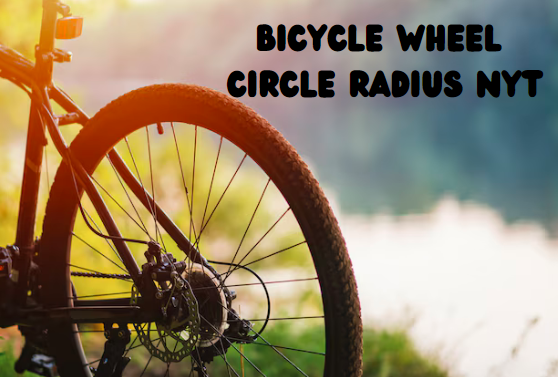Bicycle Wheel Circle Radius NYT: The Secret to Maximizing Performance and Comfort
In the world of cycling, the importance of wheel size cannot be overstated. Whether you’re a casual rider who enjoys weekend jaunts or a competitive cyclist pushing for new personal records, understanding the role of your bicycle wheel circle radius can be the secret weapon in your cycling arsenal. The term “bicycle wheel circle radius NYT” has sparked curiosity and debate, making it an essential consideration for anyone serious about maximizing their performance and comfort on the road.
In this comprehensive article, we’ll explore the nuances of the bicycle wheel circle radius, delving into its impact on various aspects of cycling. We’ll examine how the radius affects speed, handling, and comfort, while also considering the latest trends and innovations in wheel design. By the end of this article, you’ll have a deeper understanding of how to choose the right wheel size for your specific needs, whether you’re commuting, touring, or racing.
What Is the Bicycle Wheel Circle Radius?
The bicycle wheel circle radius is a fundamental measurement that refers to the distance from the center of the wheel (the hub) to the outer edge (the tire). This radius is a crucial determinant of the wheel’s overall diameter, which in turn influences the bike’s performance, stability, and comfort. The larger the radius, the larger the wheel, and each size brings with it a unique set of advantages and trade-offs.
Understanding the concept of the wheel radius helps cyclists make informed decisions about their bike setup, whether they’re selecting a new bike, upgrading their current one, or adjusting their ride to meet specific conditions.
How to Measure the Bicycle Wheel Circle Radius
Measuring the bicycle wheel circle radius is a relatively straightforward process. Here’s how you can do it:
- Position the Bike: Place the bike on a level surface with the wheels fully inflated. Ensure that the bike is upright and stable.
- Identify the Center Point: Locate the center of the wheel, where the hub is located. This is the point from which you’ll measure the radius.
- Measure to the Edge: Using a ruler or tape measure, measure the distance from the center of the hub to the outer edge of the tire. This distance is the wheel radius.
- Calculate the Diameter (Optional): If you want to know the diameter, simply double the radius measurement.
This simple process gives you the wheel radius, a key figure that can be used to better understand the performance characteristics of your bike.
Why Bicycle Wheel Circle Radius Matters
The radius of your bicycle wheel has far-reaching implications for your riding experience. Here are some of the critical ways that the wheel radius influences your ride:
1. Speed and Acceleration
The size of the wheel, as determined by the radius, directly impacts speed and acceleration. Larger wheels (with a larger radius) typically roll faster, making them ideal for long-distance rides and racing. They cover more ground per rotation compared to smaller wheels, which can give riders a speed advantage on flat terrain.
However, larger wheels require more effort to get up to speed. This means that while they are great for maintaining high speeds, they may not accelerate as quickly as smaller wheels, which can be more agile and responsive in stop-and-go situations.
2. Handling and Stability
Handling and stability are also affected by the wheel radius. Larger wheels provide a smoother ride, especially on rough or uneven terrain. They have a greater ability to “roll over” obstacles like rocks and potholes, making the ride more stable and comfortable.
On the other hand, smaller wheels offer more nimble handling, which can be advantageous in tight corners or in urban environments where quick maneuvers are necessary. The choice between stability and agility often depends on the type of riding you do most often.
3. Comfort and Ride Quality
Comfort is a significant factor for many cyclists, particularly those who ride long distances. The wheel radius plays a crucial role in ride quality, with larger wheels generally offering a more comfortable experience. This is because larger wheels reduce the impact of bumps and vibrations from the road, leading to less fatigue over time.
Smaller wheels, while less comfortable on rough surfaces, can provide a more direct connection to the road, which some riders prefer. The choice between comfort and responsiveness often comes down to personal preference and the specific demands of your riding style.
The Impact of Bicycle Wheel Circle Radius on Different Types of Cycling
Different cycling disciplines require different characteristics from a bike’s wheels. Let’s explore how the bicycle wheel circle radius affects various types of cycling:
1. Road Cycling
In road cycling, speed and efficiency are paramount. As such, larger wheels (with a larger radius) are often favored for their ability to maintain high speeds with less effort. Road bikes typically feature 700c wheels, which offer a good balance between speed, comfort, and handling. The larger radius helps road cyclists cover long distances quickly, making them ideal for racing and endurance rides.
2. Mountain Biking
Mountain biking demands a different approach to wheel size. Here, the terrain is often rough and unpredictable, requiring wheels that can handle a variety of surfaces. Larger wheels, such as 29-inch wheels, are popular in mountain biking because they provide better rollover ability, helping riders maintain momentum over rocks, roots, and other obstacles.
However, some mountain bikers prefer smaller wheels, like 27.5-inch wheels, for their agility and quicker acceleration. These wheels offer better control in tight, technical sections of the trail, where maneuverability is crucial.
3. Commuting
For commuters, the choice of wheel radius can depend on the specific needs of the rider. Larger wheels can make the ride smoother and more efficient, especially on longer commutes. However, smaller wheels may be preferable in urban environments where quick turns and acceleration are necessary to navigate traffic and crowded streets.
Foldable bikes, which are popular among commuters, often feature smaller wheels for portability. While these wheels may sacrifice some comfort, they make up for it with convenience and maneuverability.
4. Touring
Touring bikes, designed for long-distance travel with heavy loads, often feature larger wheels to enhance comfort and stability. The larger radius helps absorb road vibrations and smooth out the ride, which is essential when spending hours in the saddle each day. These wheels are typically built for durability, with a focus on reliability over rough terrain.
Touring cyclists also appreciate the ability of larger wheels to maintain momentum, making it easier to cover long distances with less effort.
Innovations and Trends in Bicycle Wheel Design
The cycling industry is constantly evolving, and wheel design is no exception. Several innovations and trends have emerged in recent years that are worth noting for those interested in optimizing their bicycle wheel circle radius.
1. Aero Wheels
Aero wheels are designed to reduce aerodynamic drag, allowing cyclists to maintain higher speeds with less effort. These wheels typically have a deeper rim profile, which improves airflow around the wheel. While the radius of the wheel remains a critical factor, the shape of the wheel and its ability to cut through the air is also important.
Aero wheels are particularly popular in road cycling and triathlon, where every second counts. However, they can be more challenging to handle in crosswinds, and their benefits are most noticeable at higher speeds.
2. Tubeless Wheels
Tubeless wheels have become increasingly popular in both road and mountain biking. These wheels allow riders to forgo inner tubes, reducing the risk of punctures and allowing for lower tire pressures. Lower pressure improves traction and comfort, particularly on rough terrain.
The radius of the wheel still plays a vital role, but tubeless technology enhances the performance and comfort of the wheel, making it a valuable consideration for serious cyclists.
3. Carbon Fiber Wheels
Carbon fiber wheels are lightweight and strong, offering significant performance advantages over traditional aluminum wheels. The reduced weight of carbon wheels can improve acceleration and climbing ability, particularly in competitive cycling.
While carbon fiber wheels can be more expensive, their performance benefits make them a popular choice among racers and serious enthusiasts. The radius of the wheel, combined with the lightweight properties of carbon fiber, creates a potent combination for maximizing speed and efficiency.
4. Wide Rims
Wide rims have gained popularity for their ability to improve tire performance. A wider rim allows the tire to sit more naturally, improving traction and stability. This is particularly beneficial in mountain biking, where grip and control are essential.
Wide rims also contribute to a more comfortable ride by allowing for lower tire pressures, which can absorb more bumps and vibrations. The combination of a larger radius and a wider rim creates a versatile wheel that excels in a variety of conditions.
Choosing the Right Bicycle Wheel Circle Radius for Your Needs
Selecting the right wheel radius for your bike depends on several factors, including your riding style, the terrain you’ll be covering, and your personal preferences. Here are some key considerations to help you make the best choice:
1. Assess Your Riding Style
Your riding style plays a significant role in determining the optimal wheel radius. If you’re a road cyclist focused on speed and long-distance efficiency, a larger wheel radius is likely the best choice. On the other hand, if you’re a mountain biker who values agility and control on technical trails, a smaller wheel radius may be more suitable.
Commuters and touring cyclists should consider the specific demands of their rides. For example, if your commute involves navigating city streets with frequent stops and turns, a smaller wheel radius might offer better maneuverability. If you’re touring across varied terrain, a larger radius will provide the comfort and stability needed for long days in the saddle.
2. Consider the Terrain
The terrain you’ll be riding on is another crucial factor in choosing the right wheel radius. For smooth, paved roads, larger wheels offer speed and efficiency. For rough, uneven trails, a larger wheel radius can help you maintain momentum and stability, while a smaller radius provides better control in tight, technical sections.
If you frequently switch between different types of terrain, you may need to find a compromise or consider a bike with multiple wheel options that can be swapped out depending on the ride.
3. Factor in Comfort and Fit
Comfort is key to enjoying your ride, especially on longer journeys. A larger wheel radius generally offers a smoother ride, reducing fatigue and allowing you to ride longer with less discomfort. However, the fit of the bike is equally important. Ensure that the wheel size you choose complements the frame size and overall geometry of your bike, allowing for a comfortable and efficient riding position.
4. Test Different Options
If you’re unsure which wheel radius is right for you, consider testing different options. Many bike shops offer demo bikes or the ability to swap out wheels, allowing you to experience the differences firsthand. Pay attention to how each wheel size affects your speed, handling, and comfort, and choose the one that feels best for your specific needs.
Bicycle Wheel Circle Radius NYT: The Role of The New York Times in Popularizing the Concept
The phrase “bicycle wheel circle radius NYT” has gained traction, in part due to discussions and articles published by The New York Times. The paper’s coverage of cycling topics, including wheel size, has helped bring attention to the importance of the wheel radius in optimizing cycling performance.
The New York Times has long been a trusted source of information on a wide range of topics, and its exploration of cycling trends and technologies has contributed to the broader understanding of the impact of wheel radius on the cycling experience. By highlighting the latest research and expert opinions, the NYT has helped cyclists of all levels make more informed decisions about their equipment.
FAQs About Bicycle Wheel Circle Radius NYT
Q1: What is the ideal bicycle wheel circle radius for road cycling?
A: For road cycling, a wheel radius that results in a 700c wheel size is ideal. This size balances speed, comfort, and handling, making it the most popular choice for road cyclists.
Q2: How does the wheel radius affect mountain biking?
A: In mountain biking, a larger wheel radius (such as 29 inches) improves rollover ability and stability on rough terrain, while a smaller radius (like 27.5 inches) offers better agility and control in technical sections.
Q3: Can I change the wheel radius on my existing bike?
A: Changing the wheel radius on your bike typically requires swapping out the wheels for a different size. However, this may also necessitate adjustments to the bike’s frame, brakes, and gearing, so it’s important to consult with a bike mechanic before making any changes.
Q4: What role does The New York Times play in the popularity of the bicycle wheel circle radius concept?
A: The New York Times has published articles and discussions that highlight the importance of the bicycle wheel circle radius, helping to raise awareness among cyclists and contributing to the broader understanding of its impact on performance and comfort.
Q5: Are larger wheels always better for comfort?
A: While larger wheels generally offer a smoother ride by reducing the impact of bumps and vibrations, the best wheel size for comfort also depends on other factors, such as tire pressure, rim width, and the bike’s overall geometry.
Conclusion: Mastering the Bicycle Wheel Circle Radius NYT
The bicycle wheel circle radius is more than just a technical detail—it’s a critical factor that can significantly influence your cycling experience. Whether you’re seeking speed, comfort, stability, or agility, understanding the impact of wheel size is essential to making the right choices for your riding style and goals.
As you’ve learned in this article, the right wheel radius can enhance your performance and comfort, whether you’re racing on the road, tackling rugged trails, or commuting through the city. By considering the insights provided here, along with the latest trends and innovations in wheel design, you’ll be well-equipped to optimize your bike for the best possible ride.
Remember, the journey to becoming a better cyclist involves not just training and practice, but also making informed decisions about your equipment. The bicycle wheel circle radius NYT could be your secret weapon in achieving new levels of cycling excellence.






